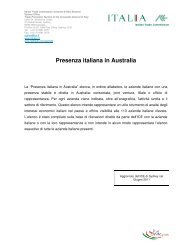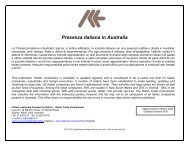Price Determination in the Australian Food Industry A Report
Price Determination in the Australian Food Industry A Report
Price Determination in the Australian Food Industry A Report
You also want an ePaper? Increase the reach of your titles
YUMPU automatically turns print PDFs into web optimized ePapers that Google loves.
Figure 39. Lamb market sales, ’000 tonnes per annum, 1997–2002<br />
’000<br />
tonnes<br />
500<br />
400<br />
300<br />
200<br />
100<br />
export<br />
domestic<br />
0<br />
1997 1998 1999 2000 2001 2002<br />
Source: ABARE<br />
<strong>Price</strong> <strong>Determ<strong>in</strong>ation</strong> <strong>in</strong> <strong>the</strong> <strong>Australian</strong> <strong>Food</strong> <strong>Industry</strong> A <strong>Report</strong><br />
Major drivers of price<br />
• Despite <strong>the</strong> high proportion of meat go<strong>in</strong>g <strong>in</strong>to <strong>the</strong> domestic market, returns to <strong>the</strong> lamb<br />
production and process<strong>in</strong>g sector are strongly <strong>in</strong>fluenced by world trade through prices<br />
demanded by overseas customers. Domestic market consumption is relatively static and subject<br />
to price competition from o<strong>the</strong>r red and white meats.<br />
• A major <strong>in</strong>fluence <strong>in</strong> recent years has been <strong>the</strong> decl<strong>in</strong>e <strong>in</strong> product availability on <strong>the</strong> world<br />
market from o<strong>the</strong>r major production countries <strong>in</strong> <strong>the</strong> face of ris<strong>in</strong>g demand <strong>in</strong> <strong>the</strong> major markets<br />
of <strong>the</strong> United States, Japan and <strong>the</strong> European Union. These trends are expected to cont<strong>in</strong>ue <strong>in</strong>to<br />
<strong>the</strong> foreseeable future.<br />
• With grow<strong>in</strong>g export <strong>in</strong>fluence on <strong>the</strong> sector, <strong>the</strong> supply of lambs and accord<strong>in</strong>gly <strong>the</strong> prevail<strong>in</strong>g<br />
prices over time are driven by o<strong>the</strong>r factors which <strong>in</strong>clude:<br />
– exchange rate relativity and volatility;<br />
– seasonal conditions which affect both quality and quantity of stock. Drought may delay <strong>the</strong><br />
sale of new season or sucker lambs, caus<strong>in</strong>g shortages (as seen <strong>in</strong> July and<br />
August 2003). Ra<strong>in</strong>fall provides good feed and quicker turnoff of lambs which may <strong>in</strong>crease<br />
supply and lower prices;<br />
– as <strong>the</strong> <strong>in</strong>cidence of feedlots for lamb <strong>in</strong>creases, <strong>the</strong>re will be a greater exposure to<br />
commodity risks such as gra<strong>in</strong> prices, import regulations and so on; and<br />
– <strong>the</strong> returns from wool – although, with <strong>the</strong> strong role played by cross-breeds <strong>in</strong> sheep<br />
and <strong>in</strong>creas<strong>in</strong>g specialisation <strong>in</strong> lamb production, this <strong>in</strong>fluence is weaken<strong>in</strong>g.<br />
• The behaviour of consumer segments <strong>in</strong> key markets such as <strong>the</strong> United States will cont<strong>in</strong>ue to<br />
drive change through <strong>the</strong> lamb sector and <strong>in</strong>crease <strong>the</strong> focus on specialisation of production for<br />
those markets.<br />
• In recent times, <strong>the</strong> strength of export demand, coupled with a reduction <strong>in</strong> <strong>the</strong> total available<br />
lamb production as a result of <strong>the</strong> drought, has sharply <strong>in</strong>creased prices paid for lambs at<br />
producer and processor level.<br />
Major drivers of domestic prices<br />
Domestic retail prices <strong>in</strong> recent years have been driven by retailers sett<strong>in</strong>g prices at sufficient<br />
marg<strong>in</strong> over costs, balanced aga<strong>in</strong>st prices of compet<strong>in</strong>g meats at retail.<br />
Domestic market consumption is relatively static and subject to price competition from o<strong>the</strong>r red<br />
and white meats. The consumer is sensitive to <strong>the</strong> pric<strong>in</strong>g differentials between <strong>the</strong> meat choices,<br />
whilst also show<strong>in</strong>g greater <strong>in</strong>terest <strong>in</strong> meat that is tailored to different eat<strong>in</strong>g and cook<strong>in</strong>g styles.<br />
44







